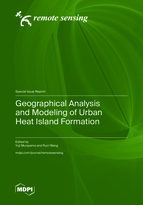Geographical Analysis and Modeling of Urban Heat Island Formation
A special issue of Remote Sensing (ISSN 2072-4292). This special issue belongs to the section "Urban Remote Sensing".
Deadline for manuscript submissions: closed (31 October 2022) | Viewed by 45037
Special Issue Editors
Interests: human geography; GIScience; geospatial analysis; spatial modeling; urban geography
Special Issues, Collections and Topics in MDPI journals
Interests: urban studies; GIS; remote sensing; urban heat island; urban growth
Special Issues, Collections and Topics in MDPI journals
Special Issue Information
Dear Colleagues,
The urban heat island (UHI) phenomenon, related to rapid urbanization, has attracted considerable attention from academic scholars and governmental policymakers because of its direct influence on citizens’ daily lives. The UHI effect causes a series of negative human impacts, including indirect economic loss, poor air quality, reduced comfort, imbalanced public health, and increased mortality rate. The temperature difference between the center and the periphery is expanding, especially in big cities. It could be the result of changes in land use/cover composition and increasing anthropogenic heat sources. Monitoring and modeling urban heat island formation are crucial to managing sustainable development, especially in developing countries.
This Special Issue focuses on data, method, techniques, and empirical outcomes of urban heat island studies from a time and space perspective. We wish to showcase your research papers, case studies, conceptual or analytic reviews, and policy-relevant articles to help to achieve urban sustainability.
Areas of interest include but are not necessarily restricted to:
- Methodology and datasets for capturing urban heat island phenomena;
- Novel techniques for urban heat island monitoring and forecasting with remote sensing and GIS;
- Spatial relationship between urban heat island intensity and land use/cover distribution in metropolitan areas;
- Geographical pattern and process of urban heat island phenomena in big cities through empirical studies;
- Spatial difference of urban heat island intensity between developing and developed counties;
- Urban heat island disaster mitigation and adaptation for future urban sustainability;
- Prediction and scenario analysis of urban heat island formation for policy and planning.
You may choose our Joint Special Issue in Geomatics.
Prof. Dr. Yuji Murayama
Dr. Ruci Wang
Guest Editors
Manuscript Submission Information
Manuscripts should be submitted online at www.mdpi.com by registering and logging in to this website. Once you are registered, click here to go to the submission form. Manuscripts can be submitted until the deadline. All submissions that pass pre-check are peer-reviewed. Accepted papers will be published continuously in the journal (as soon as accepted) and will be listed together on the special issue website. Research articles, review articles as well as short communications are invited. For planned papers, a title and short abstract (about 100 words) can be sent to the Editorial Office for announcement on this website.
Submitted manuscripts should not have been published previously, nor be under consideration for publication elsewhere (except conference proceedings papers). All manuscripts are thoroughly refereed through a single-blind peer-review process. A guide for authors and other relevant information for submission of manuscripts is available on the Instructions for Authors page. Remote Sensing is an international peer-reviewed open access semimonthly journal published by MDPI.
Please visit the Instructions for Authors page before submitting a manuscript. The Article Processing Charge (APC) for publication in this open access journal is 2700 CHF (Swiss Francs). Submitted papers should be well formatted and use good English. Authors may use MDPI's English editing service prior to publication or during author revisions.
Keywords
- Land surface temperature
- Surface urban heat island
- Urbanization
- Climate change
- Land use/cover change
- Machine learning
- Scenario analysis
- Urban–rural gradient analysis
- Time and space
- Public health
- Urban ecosystem services
- Urban living environment
- Urban heat island adaptation
- Urban planning







